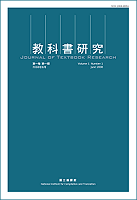|
|||||||
|
|
|||||||
| 最新卷期 Current Issue |
第五卷 第一期 Vol.5 No.1 |
所有卷期 All Issues |
投稿須知 For Authors |
| 第五卷 第一期 Volume 5 Number 1 |
[完整版 | Entire Version] 
|
|
|
|
|
主編的話
歐用生 周淑卿
Editors' Note
Yung-Sheng Ou Shu-Ching Chou
|
|
|
中小學教科書審定委員會組織及職權定位之研究
曾大千 陳玲璋 劉淑津
Examining the Organization and Objectives of Elementary and High School Textbooks Review and Approval Committees
Dah-Chian Tseng Ling-Jan Chen Shu-Chin Liu
|
|
|
Mainland China’s Unified Textbook System of the Early 1950s: Historical Significance and Practical Lessons
Ou Shi Xiao-Ou Wu
|
|
|
以教科書之插圖與版式設計增進教學藝術之觸發──以社會科教科書為例
詹寶菁 葉韋伶 陳麗華
Applying Illustrations and Layout Design for Textbook to Enhance the Art of Teaching: A Case of Social Studies Textbook
Bao-Jing Chan Wei-Ling Yeh Li-Hua Chen
|
|
|
小學國語教科書第三人稱代名詞的性別語義特徵之內容分析
黃秋華 陸偉明
Analysis of Third Person Pronouns with Gender Semantic Features in Elementary School Mandarin Textbooks
Chiu-Hua Huang Wei-Ming Luh
|
|
|
|
|
|
An Evaluation of Geological and Environmental Teaching Materials in 5th and 6th Grades Science and Technology Textbooks
Yu-Hsuan Wang
|
|
|
|
|
|
Japan Textbook Research Center
Yi-Jen Lin
|
|
本刊投稿及編務事宜連絡,請函寄:10644臺北市大安區和平東路一段179號4樓,或E-mail:ej@mail.naer.edu.tw
Manuscripts and all editorial correspondence should be sent to:
4F, 179 Sec. 1, Heping E. Rd., Daan Dist., Taipei City 10644, Taiwan (R.O.C.), or E-mail:ej@mail.naer.edu.tw
4F, 179 Sec. 1, Heping E. Rd., Daan Dist., Taipei City 10644, Taiwan (R.O.C.), or E-mail:ej@mail.naer.edu.tw





